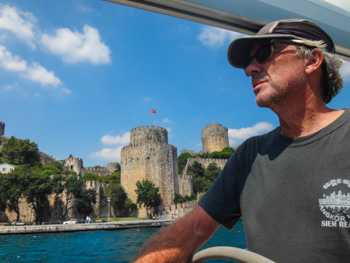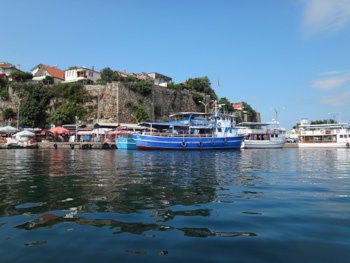
Tenaya
August
2014
Part One
Stories from Sailing
Turkey's Black Sea Coast
| |
| HOME |
| About Tenaya |
| About Us |
| Latest Update |
| Logs from Current Year |
| Logs from Previous Years |
| Katie's View |
| Route Map |
| Links |
| Contact Us |
![]()
August 30, 2014
It's like fireworks going off in our heads. "We're sailing up the Bosphorus!" Jim and I say to each other more than once. Three months ago we were in Phuket thinking Tenaya was going to Antwerp. Now she is skimming along the dividing line between Europe and Asia.
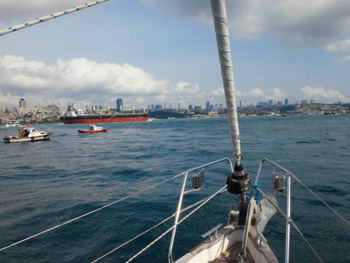
Technically, we are not sailing. It's forbidden in the 30 mile long Bosphorus Strait because of traffic. I'll use the term anyway because we are going somewhere on our sailboat for the first time in four months and I am so excited I just might pop.
We pass the Blue Mosque and the Hagia Sophia Museum. Their massive domes and spindly minarets dominate the historic center of Istanbul, the point where the Bosphorus Strait drains into Marmara Sea.
A shipping lane runs up the middle so we make our way along the eastern edge. Here and there boats are tied to seawalls in front of restaurants and mansions. Green hills with outcroppings of homes and clusters of communities rise above and roll away from the banks. The current, which can be up to 4 knots in places, creates swirls and boils where the waterway bends.

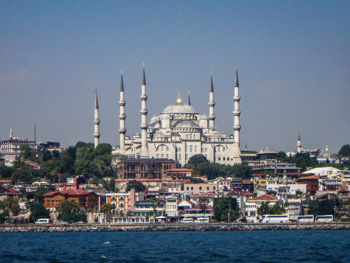
Poyrazköy
41 12'.28N : 029 07'.75E
Poyrazköy is the last anchorage in the Bosphorus before the Black Sea. The inner harbor is filled with fishing boats and the outer harbor is scattered with pleasure boats. We do a lap to check depths and decibels, choose our spot, and are settled by 1430. Tenaya is the only sailboat.
Two restaurants in the curve of the small bay have rows of colored umbrellas and lounge chairs planted in what looks like dirt, not sand. Yellow plastic kayaks and blue pedalboats shaped like conjoined dolphin twins lie at the water's edge.
It's Saturday and the weather is gorgeous. People in groups float, flounder and swim while kayaks and dolphins meander and small skiffs buzz through the anchorage. It grows more crowded by the minute. Apparently every local with a boat has crammed all his family and friends aboard and chugged up here to stake out a spot and do the beach thing.
Music blares, mostly Turkish pop. Guys wear trunks, not marble bags, and women wear everything from bikinis to burqas and hijabs. Because there is no privacy outside (people swim by and hang onto our windvane) I take my shower inside.
As I'm drying off, I glance out the window. A dolphin pedalboat floats just off our port side. In the water, between the two blue heads, bobs a young couple entwined in passion. Our guidebook says public displays of affection are discouraged and I duck back hoping they didn't see me.
A few minutes later there is a loud crash. Jim is reading in the cockpit and yells, "Stop, stop, there are people. Stop!"
Climbing into the cockpit, I see a marshmallow white 50' multi-level powerboat towering over the guy who is now clinging to a dolphin head. "Where's the girl?" I ask, frantically looking around.
Jim points to our stern where she's treading water, protected by our hull and windvane. A yelling session ensues between one of the balding men at the back of the boat and the guy in the water. I can't believe the one that squeezed his massive stinkpot between us and three other anchored boats and smashed into the pedalboat is shouting like he was wronged. Once the guy seems to apologize for being in the way, the stinkpot leaves and the lovers ride away.
The next morning the anchor and chain bring up sticky, oozing mud. We are happy to be moving on.
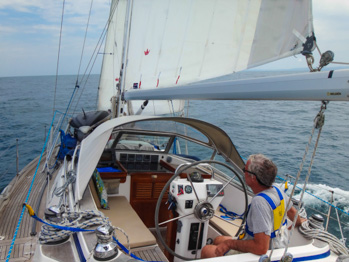
It's four hour trip to Şile. Bottlenose dolphins approach, have a look, and carry on. At 1300 the wind picks up to 10 knots and we roll out the sails. In no time the jib starts slatting in the swell. When we can't stand the rhythmic slapping any longer, we roll it in, shorten the main, straighten the boom, turn on the engine and motorsail. Purists, we are not.
A black RIB blasts out of a small harbor and hones in on us. Five members of the Sahil Güvenlik, the Coast Guard, pull up alongside. One asks for our papers in English. He wants our Turkish waters transit log, passports, USCG registration and the builder's certificate. I flash back to Hogan's Heroes 'your papers, please' and hope they don't drop our passports into the sea.
Şile
41 10'.74N : 029'.36'.36E
The small harbors along the Karadeniz, the Black Sea, are for fishing boats. If room allows, pleasure boats are welcomed to anchor. The harbor in Şile can accommodate about a dozen free-swinging boats and we arrive to find just two others, both daytrippers.
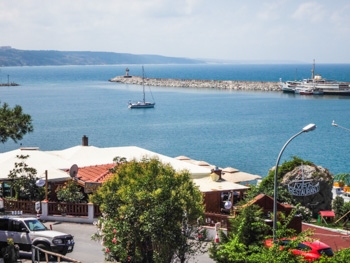

The streets of Şile are quiet and the ambiance is pleasant. Rocky islets protect a swimming area adjacent to the harbor. Shades of blue and turquoise suggest interesting snorkeling although none of the men swimming have any gear.
The ruins of a small stone castle sit atop the tallest islet. It is being restored and has already lost its ancient charm. We climb the stairs from the harbor to town and then more stairs to the top of the headland and find a lovely panoramic view of the scalloped coastline.


The Cloth Culture and Art Festival is in full swing. Locally woven cotton apparel with stitched designs hang along the main cobblestoned street. Interspersed are sparkling gemstone rings and carved walking sticks.
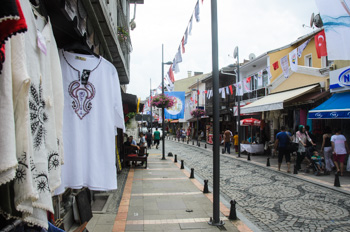
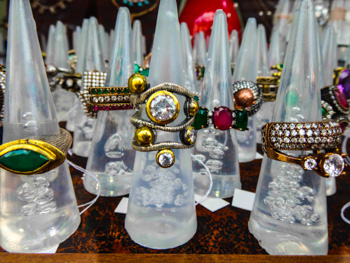
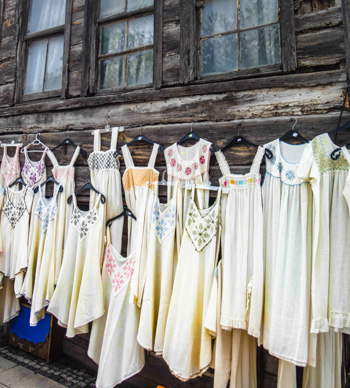
We wander by shops and seafood restaurants. The scent of fresh bread draws us inside a bakery and we leave with a warm loaf. A few doors down is an ice cream stand that we can't ignore. Looking for a spot to relax and enjoy our melting treat, I see the baker motioning for us to return and sit on the bench in front of his shop.
Teşekkurler, thank you, I say as he eases down next to Jim. He says something in Turkish and I point to Jim and myself and say 'tourists' with an apologetic grin. He shows us a plaque on the wall that says the shop has been there for more than a century. I try to ask if it has always been in his family but give up.
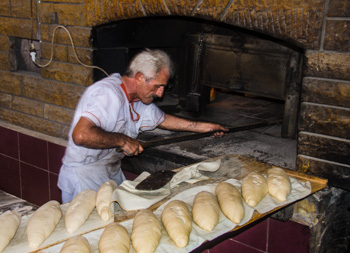
Monday we report to the harbormaster. He checks our papers and asks how long we plan to stay. We say we'll leave the next day.
In the late afternoon we pass the harbormaster's building on the way to our kayak. We left it on the haul-out ramp after a nod from a fisherman working on his boat. Two employees are drinking tea at an outside table. When we say merhaba, hello, they invite us to join them. The guy disappears, Jim sits quietly, and Aysun and I chat in broken English. I like her immediately. She tells me about her son in university. I tell her we will stop in Şile on our way back to Istanbul. We agree to drink tea together again and become Facebook friends.
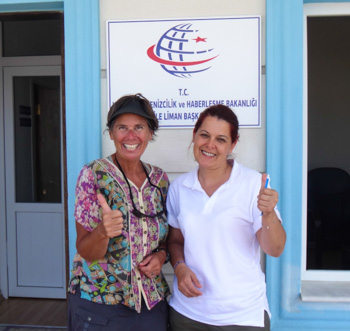
That night Jim and I have dinner at a restaurant tucked into a rocky nook of the harbor. As the sun sets, wisps of yellow, orange and red spread across the horizon.
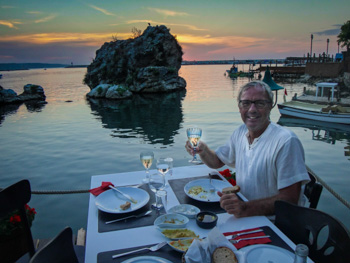
On the way out in the morning, in an effort to avoid the shallow parts of the silting entrance, we hugged the mole a little too much. Luckily the bottom is soft and a blast of reverse frees Tenaya's keel.
It is an overnighter to Amasra 135 miles further east. At 1245 the wind hits 7 knots on the beam and we roll out the sails. Yippee! It's our best sailing since somewhere in the Sulu Sea.
At 1400 dolphins come.
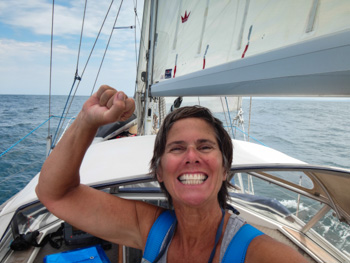
Big ships begin to appear at 1600. All night long there are at least three in close proximity. Most are going our direction or the reciprocal and are a mile a way or more. At one point, one ship approaching from behind is .5 mile CPA, Closest Point of Approach, so Jim alters course. When he alters a second time, at 2258, the tanker T. Sevgi calls our MMSI number to find out his intentions.
According to COLREGS, the International Regulations for Preventing Collisions at Sea, the boat being overtaken is to maintain its course. But when a big ship is bearing down on us we get out of the way. Best to be early, decisive and not swagger.
After a mesmerizing sunrise, we reach Amasra at 1100.
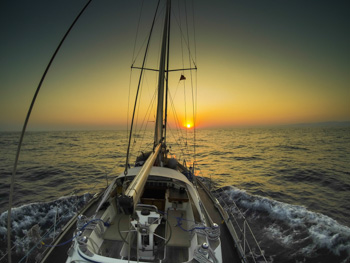
Amasra
41 44'.77N : 032 23'.48E
What a beautiful location! We anchor in the new harbor (as opposed to the old harbor to the west) in 8 meters and are far enough from the crowded beach for privacy. The boat hardly moves in this well-protected spot and the anchor is stuck like glue in the mud. There is a small, mostly empty marina under the fortress wall. Large fishing and tour boats are tied to the concrete quay on both sides. Where the bay curves, dozens of small fishing boats have been pulled up on shore. Tenaya floats near the long Sahil Güvenlik dock where two of their vessels are tied. Only kids sailing dinghies come near.
The Joneses' small yacht is tied in the corner of the marina. They sailed from England, came down the Danube, entered the Black Sea in Romania and moved along the coast of Bulgaria to Turkey. They are on their way to Georgia where they hope to winter aboard. The marina is nice, they say, because their boat doesn't have a windlass and hauling up the anchor every day or two is tiring and painful on their aging bodies.
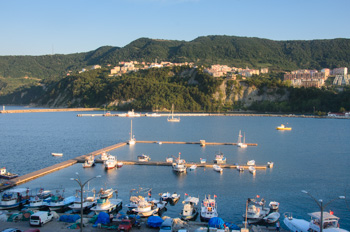
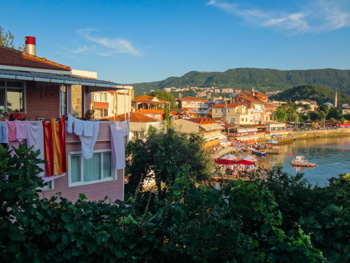
Amasra is cozy and touristy and delightful. Restaurants line the shore and streets branch out across the neck to the old harbor where there is another long, sandy beach and a rocky point that is a perfect place to jump into the sea.
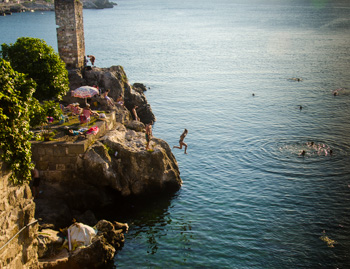
A bridge made of stone links to an island that protects the old harbor. A road and staircase lead up the bluff above the new harbor to the remains of a castle. A maze of narrow streets wend through the ruins and huddling houses. As we round a bend to ascend more stone steps, I almost step on a cat nursing five tiny kittens.
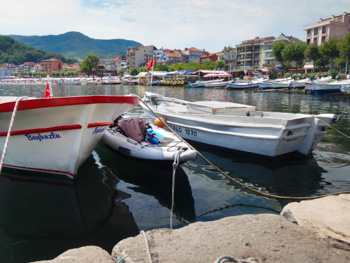
Amasra is old. The first residents were the Amazons, the fierce women warriors. Next the Phoenicians came, then the Ionians, Carrions, Aka Peoples, Persians, Pontus People, Romans, Byzantines, Genoese and Ottomans.
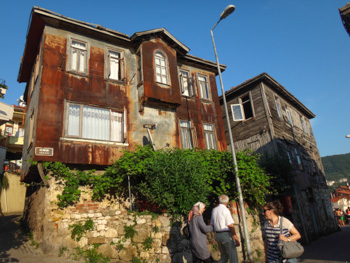
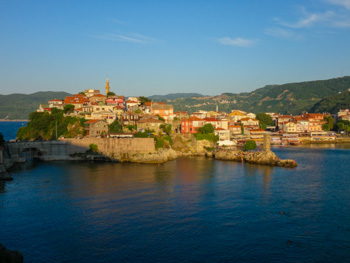
We stumble upon a daily market while exploring Amasra the first day. Faithful ladies from the countryside sell their homegrown fruit, veggies and herbs and homemade jars of honey flavored with fruit and nuts, bags of grain and spices for çorba, a thick soup, and cheese. Lots of cheese. Despite all the people, the market is calm and quiet.
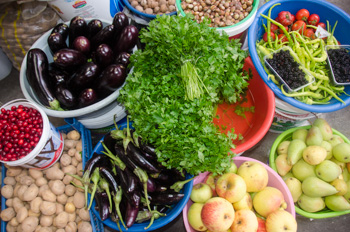
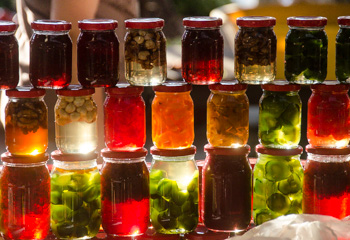
When I ask a young woman if we can take photos of the jars of honey, she says yes, then starts explaining what they are. In Turkish. I ask her to write down the names then look them up in my dictionary.
When I don't know what something is, she offers me a taste. I give it a thumbs up and buy a jar. She offers me tastes of more flavors. I buy them all until one tastes like sweetened dirt. A young girl giggles when I take a swig from my water bottle.
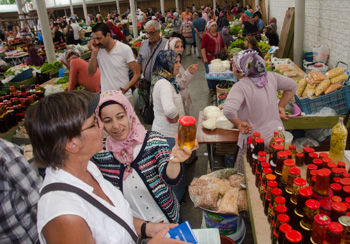
Green vegetation I've never seen before is piled on a table. I look at the short, drying stems with bulbous yellowing ends, then at the women standing there. I hope my expression conveys dismay. One points to a bucket of findiks, hazelnuts. The younger woman teaches me how to pop them out of the husks. As we leave, the lady gives me a handful of the scratchy clippings.
Approximately 75% of the world's hazelnut supply comes from Turkey's Black Sea coast. Most of it goes to Ferraro, the Italian makers of Nutella. Turkey has a few of their own cocoa and hazelnut spreads. One company, Sarelle, has been in business since 1936. Their product is good. Ask me how I know.


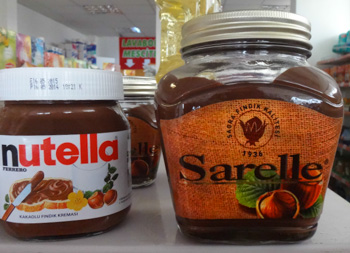
The magnificent light (which reminds me of Venice), the colorful buildings, ancient walls, small handicraft shops, marketplace, abundant spots to jump off rocks and swim, and the tasty kebap stands all tempt us to linger. I hear my native tongue only a few times - from the Joneses and from Jess.
Jess is also English. She rode her bike from London and is headed to Georgia. She figures she'll make it to Thailand in a few months. I'm a little embarassed to reveal we shipped Tenaya from there to Istanbul.
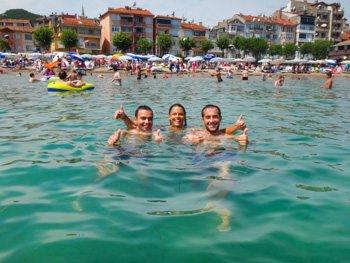
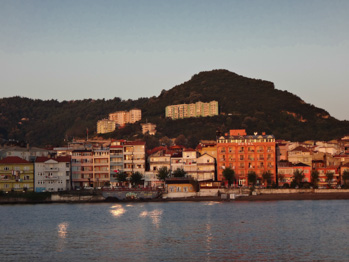
We stay in Amasra four days then leave at dawn for another overnighter. Our destination is Sinop, the northernmost city in Turkey. It's on a peninsula that wraps around and creates the only south-facing beach on this coast. A popular holiday destination, I have a mental image of something like Amasra turned 90 degrees.
Just after 1300 A large white Sahil Güvenlik ship belching dark smoke appears from the east and hails us on the radio. A heavily accented voice asks what country we are from, how many people are on board, what our previous and intended destinations are and if we have a transit log. All the time he's closing in. We think he says 'stay there' so we roll in the sails then roll in the swell. The ship comes close, does a loop around us, says something inaudible on the radio, and heads away. We stay put until it's a speck on the horizon, then continue.
Some excerpts from that night's log:
1900: dolphins come again 2019: SUPER MOON! Big and yellow on the starboard bow. (happy face drawing) 0303: 2 AIS targets, 1 gaining from astern .4 CPA 0600: Sunrise=big red ball. 0900: Approaching Sinop.
Tall apartment buildings cover the hillside the entire length of the south-facing coast. We try to tie along a seawall near the ferry dock but hit bottom so poke our nose into the smaller harbor. There is no room. Large fishing boats are tied two and three deep. We leave and head for nearby Gerze where a marina is tucked into the large bay. Before entering, we decide to keep going to Samsun.
I see a flashing light across the bay and peer through the binoculars. It's the Sahil Güvenlik. Whether they are they signalling us or it's just a reflection, I can't tell. Fifteen minutes later a RIB ties to starboard. It bucks and slams against our hull in the chop and I adjust the lines but it does no good. Before they ask, Jim hands them our papers.
One guy says that someone reported a sailboat near Gerze with nobody on board. We say we were there, the boat was on autopilot and we were sitting in the shade of the sprayhood. Satisfied, they still check our papers. He says the Coast Guard has a Beneteau that he races further south. He's keen to talk about sailing. They are nice so I give each one a Tenaya pen. They are thrilled beyond words.
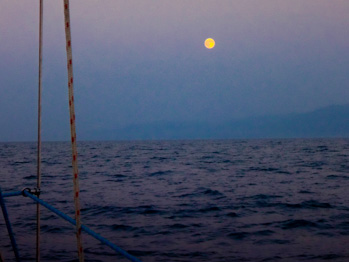
Jim calls the Samsun Yacht Club on the radio when we are outside. They say to come right in. While he's on the phone I smell something awful. I look over the side and brown is coming out of the holding tank vent. Shit!
He calls back to say we'll be delayed an hour then tries to dump the tank. So much for following the pump out rules. Nothing happens. He attaches the deckwash hose and turns on the pump as I hold it against the tank opening. Saltwater blasts in before a brown geyser bursts out. Five times. Each time I come closer to vomiting. Finally the clog clears. We haven't used the holding tank since we left Europe six years ago.
Samsun
41 19'.18N : 036 20'.12E
A man from the yacht club waves us in between a big white powerboat and a tiny red and white fishing boat. The guidebook says there are lines tailed to the quay for med-mooring but when I point to the anchor, the man nods yes.

Jim lines up three boat lengths from the wall. The breeze is blowing us to starboard, towards the tiny boat. I drop the anchor and slowly release chain until we are even with the big boat. He takes over using the control at the helm while I prepare to fend off.
It is easier to med-moor if the boats are similar in size and moored close together. Then we slowly wedge in as the boats separate. But, when there is extra room, we must deal with the drift.
Just as our stern reaches its bow, two people pop their heads out of the tiny boat to watch. Jim does it just right. We don't touch either boat even though it takes me three throws and two curses before the man can tie our windward dockline.
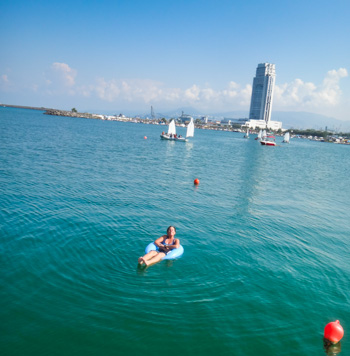
Gülay and Yüksel wave and greet us. Gülay is from Hamburg, Germany and speaks fluent English. Yüksel was born here and doesn't speak a word of it. We chat and she asks if we like fish.
The next morning the little boat is gone. By 0900 Yüksel and the boat's owner have returned and cleaned a bucket full of fish. We sit in their cockpit, which is roomier than ours, while Yüksel prepares breakfast.
He shakes salt on each palamut, the larger of two types of fish, then rolls it in cornmeal. He tosses them onto a hot frying pan glistening with oil. They sizzle to perfection before he lines them up on a plate. I lose track of how many I eat. After blue cod, this might be my favorite tasting fish. To be polite, I sample the tomato, cucumber and onion salad Gülay has prepared.
When the palamut is gone, Yüksel repeats the preparation with the smaller istavrit. It's a little more pungent and is yummy as well.
The owner worked as an ambulance driver but the stress got to him. He retired before he was 50, bought this boat, and now goes fishing most days. He explains something and Gülay translates. We are lucky, he says. The palamut only come one time of year. They are born where the Bosphorus siphons from the Black Sea at the beginning of summer and travel east doubling in size each week. They taste best at this size.
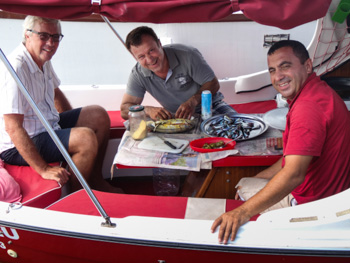

Gülay invites us to spend the night at Yüksel's family home at the beach. He grills köfte which are spicy meatballs. Jim says they are delicious so Büşra, their adorable twenty-two year old daughter, loads them on his plate until he can't eat another one.
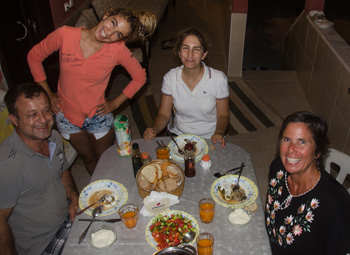
Gülay serves baklava and watermelon for desert "Do you eat watermelon in America?" she asks.
"Yes," Jim says. "On picnics and the Fourth of July mostly. Everyone barbecues hot dogs and hamburgers and we eat chips and drink beer. Watermelon is probably the only healthy thing."
Büşra looks up from her smart phone, "What do hot dogs taste like?"
The next day we rent a car and drive further east. We would rather sail to Trabzon and explore the mountains from there but we are running out of time.
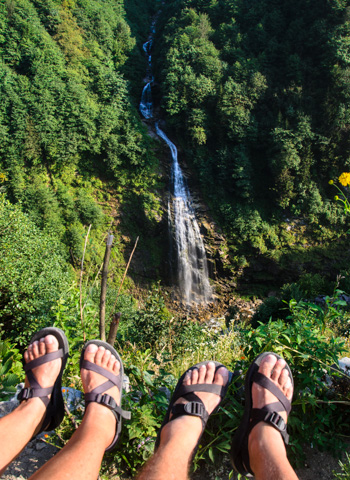
During our five day, 1200 kilometer road trip we visit the Sümela Monastery which was dug out of a cliff in the 5th century, spend the night along a lake surrounded by majestic green peaks in Uzungöl and get a mountain fix in Ayder, the gateway to the magnificent Kaçkar mountains. I'll write about it on another page.
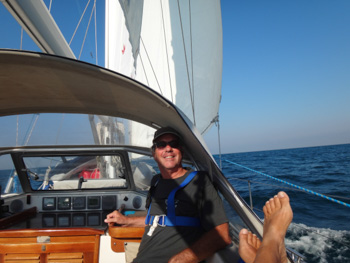
Before we are ready, we head back to Istanbul. No Sahil Güvenlik ships stop us.
As the sun goes down on Day One, about twenty dolphins come to play. They stay until well after dark, until all I can see are the patterns their spashes make on the surface. There is no bioluminescence but it's still pretty cool.
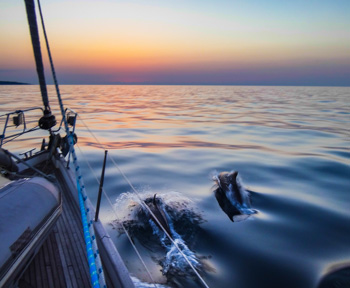
We stop in Amasra again and plan to stop in Şile for two days but the weather is changing. We don't want to be in the Bosphorus with 30 knot winds so we go all the way back to West Istanbul Marina. When she sees we didn't stop, Aysun writes a sad message on Facebook. My heart aches.
